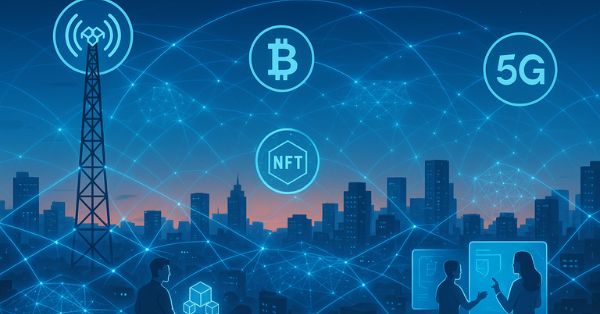The utility and energy sectors stand at the crossroads of profound transformation. As the world accelerates toward decarbonization, digitalization, and decentralization, utilities face mounting pressure to evolve — not just incrementally, but fundamentally. This transformation demands more than just smarter meters or newer control systems; it requires a rethinking of the very communications infrastructure on which all modern utility operations depend.
Enter private networks — specifically private LTE and 5G, which are emerging as essential enablers of the connected utility of the future. From enhancing grid reliability and supporting real-time automation to ensuring cybersecurity and enabling edge computing, private networks provide a resilient, secure, and future-ready foundation for mission-critical operations.
Why Utilities Must Rethink Connectivity in the Digital Grid Era
Utilities today must manage increasingly complex systems. Once reliant on centralized generation and unidirectional distribution, the modern utility must now integrate a dynamic mix of distributed energy resources (DERs) such as solar panels, wind farms, battery storage, and electric vehicles. These assets generate and consume electricity in unpredictable ways, requiring real-time coordination, control, and data-driven decision-making.
At the same time, utilities are being tasked with strengthening resilience against climate disruptions, reducing carbon emissions, enhancing operational efficiency, and ensuring compliance with stringent cybersecurity and privacy regulations. Traditional communication technologies such as VHF/UHF radios, microwave links, or even public mobile networks are no longer adequate to meet these requirements.
Private cellular networks offer a path forward. By providing dedicated wireless infrastructure owned and operated by the utility itself, these networks deliver deterministic performance, increased security, and the flexibility to tailor coverage, capacity, and quality of service to the unique needs of utility operations.
Six Strategic Reasons Utilities Are Investing in Private LTE and 5G Networks
The decision to deploy a private LTE or 5G network is not simply a technology upgrade—it’s a strategic move that supports long-term operational and regulatory goals. Private networks offer a uniquely powerful combination of reliability, performance, scalability, and cost control that public networks and legacy systems cannot match.
Utilities around the world are recognizing that managing energy in a decentralized, decarbonized, and digital age requires more than incremental improvements. It calls for a foundational shift in how infrastructure is connected and controlled. Private networks address this challenge head-on by providing a purpose-built platform to manage the full range of modern utility use cases—from advanced metering and teleprotection to mobile workforce enablement and edge analytics.
Below, we explore six primary business drivers that are compelling utilities to invest in private wireless networks:
1. Always-On Utility Communications for Mission-Critical Reliability
Utilities operate some of the most critical infrastructure in society — electricity grids, water purification systems, and gas pipelines. A communications outage during a wildfire, flood, or cyberattack can result in blackouts, service disruptions, or even loss of life. Private networks are designed to deliver “always-on” performance, with high redundancy, low latency, and full operational control. During emergencies, they ensure that SCADA systems, substations, and field crews remain connected even if public networks fail.
2. Modernizing the Grid with Real-Time, Connected Infrastructure
Modern utilities rely on thousands of devices — from smart meters and sensors to drones and remote cameras. Coordinating these assets requires real-time connectivity that is both scalable and secure. Private LTE and 5G networks enable near-instantaneous communication, supporting dynamic load balancing, predictive maintenance, and DER integration at the grid edge. As utilities evolve toward smart grids, private networks provide the digital backbone that enables automation and efficiency.
3. Securing the Grid: Improving Utility Cyber Resilience with Private Networks
As IT and OT systems converge, the threat surface grows. Cyberattacks targeting critical infrastructure are increasing in frequency and sophistication. Private networks provide physical and logical separation from public internet traffic, minimizing exposure. They also support advanced identity management, encryption, and anomaly detection tools. Importantly, they enable compliance with frameworks like NERC CIP and GDPR through localized data processing and traffic segmentation.
4. Optimizing Grid Performance with Low-Latency Private Networks
Applications like teleprotection, FLISR (Fault Location, Isolation, and Service Restoration), and voltage regulation require deterministic performance — ultra-low latency, high reliability, and zero packet loss. Unlike best-effort public networks, private cellular allows utilities to configure QoS profiles that prioritize time-sensitive traffic, guaranteeing that mission-critical applications get the bandwidth they need, when they need it.
5. Reducing Utility OPEX Through Unified Network Infrastructure
By replacing a patchwork of legacy systems — analog radios, leased lines, satellite links — with a unified private network, utilities can dramatically reduce operational overhead. Predictive maintenance, made possible by high-fidelity telemetry and AI-driven analytics, reduces truck rolls and downtime. In addition, centralized management and orchestration tools streamline operations, making utilities more agile and responsive.
6. Future-Proofing Utility Operations with Scalable Private Networks
Private networks are not just a stopgap — they are a platform for long-term innovation. With native support for edge computing, AR/VR tools, and mobile digital twins, LTE and 5G infrastructure can scale with utility needs. As standards evolve toward 5G Advanced and beyond, utilities with private networks will be positioned to seamlessly adopt next-generation capabilities without overhauling their infrastructure.
Private Networks: A Strategic Investment for the Digital Utility Future
Utilities cannot afford to rely on outdated or inadequate connectivity solutions. The stakes are simply too high. Whether it’s keeping power flowing during a storm, integrating a new solar farm, or coordinating a mobile workforce in the field, connectivity is no longer just a support function — it’s a strategic asset.
Private networks offer the reliability, security, and flexibility needed to modernize utility operations from the ground up. By investing in dedicated infrastructure today, utilities can reduce risk, improve performance, and prepare for the demands of a digital, decentralized, and decarbonized energy future.
In this next installment of the Connected Utilities blog series, we’ll explore how private networks are being used in real-world scenarios, from substation automation to drone inspections and beyond.
Explore More from the Connected Utilities Series
Continue your learning journey with our full Connected Utilities blog series:
- Why Utilities Are Investing in Private Networks to Power the Digital Grid
- Strategic Use Cases for Private Networks in the Utility Sector
- Trends Accelerating Private Network Adoption in the Utility Sector
- Deployment Architectures and Spectrum Strategies for Utility Private Networks
- Edge Computing and AI for Predictive Utility Operations
- Governance and Lifecycle Management of Utility Private Networks
- Partner Ecosystems for Scaling Utility Private Networks
- Sustainability and ESG Drivers for Private Networks
- Monetization and Shared Use Models for Utility Private Networks
- Cybersecurity and Zero Trust for Utility Private Networks
- Future Roadmap – 5G Advanced and the AI-Driven Grid
Strengthen Your Utility Private Network Strategy
Assess your grid’s 5G readiness with our industry-specific tool, uncover gaps, and get clear, executive-ready insights to plan and deploy with confidence. Check Readiness & Premium Plans



























